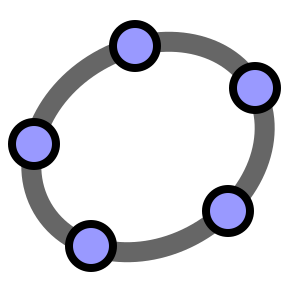GeoGebra Exercise - Universal Gravitation

This exercise will focus on using GeoGebra to visualize the mathematics and vectors associated with Newton's law of universal gravitation. It describes the force vectors experienced by two objects due to gravity. Keep in mind that gravity will always reduce to pairs of forces, even in multi-bodied systems.
PROCEDURE
- Create two points using the
 tool. These will represent the two masses somewhere in space - like planets or stars, etc.
tool. These will represent the two masses somewhere in space - like planets or stars, etc. - Create position vectors for the two objects by typing
r_A=vector[A]andr_B=vector[B]. Notice that this form of the vector function automatically assumes you want the vectors to start from the origin of the coordinate axes, which is how we define the position vectors of objects. - Since the expression for the gravitational force has the difference of the positions in it, let's show that vector as well. Type
r_A-r_B. A new vector will be shown which represents that difference. Vectors don't change upon translation (moving them). They only change if their magnitude or direction is altered. This one might look better if we move it such that it starts from point B. Rather than moving it, let's create another vector that is the same except for it's starting at point B. Typevector[B,B+u].Q1: Does this vector end at point A or at point B? While it's nice to see what this difference vector is, it will be in the way of our force vectors once we place it on the diagram, so click the bullet next to the "v" in the algebra view, which will make the object we just created invisible. - Next we need to create the force vectors. If you have a look at Newton's law of universal gravitation, you'll see that the force has the mathematical form of The vector "u" represents the term in the numerator, so we need to define a vector to represent force, and which starts at the position of point A as follows:
vector[A,A-u/length(u)^3]. - Lastly, we can place the opposite force vector (via Newton's 3rd law) on object B by typing
vector[B, B+u/length(u)^3]. - If you right click on objects you can change their colors so that you can make the diagram prettier and color coded so that each point has a different color that matches its force vector. Try doing this just for practice.